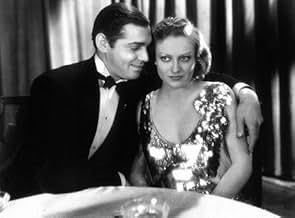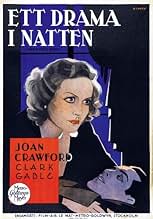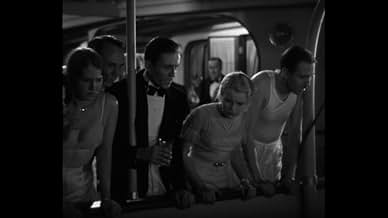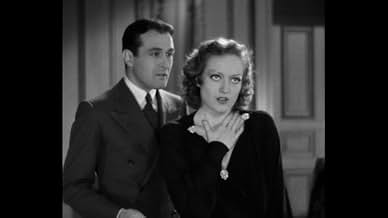Adicionar um enredo no seu idiomaAfter the death of her father and loss of the family fortune, Bonnie (Joan Crawford) gets a job as a cub reporter while her brother (William Bakewell) becomes involved in bootlegging.After the death of her father and loss of the family fortune, Bonnie (Joan Crawford) gets a job as a cub reporter while her brother (William Bakewell) becomes involved in bootlegging.After the death of her father and loss of the family fortune, Bonnie (Joan Crawford) gets a job as a cub reporter while her brother (William Bakewell) becomes involved in bootlegging.
- Direção
- Roteiristas
- Artistas
- Prêmios
- 1 vitória no total
- Wally
- (as Earl Foxe)
- Parker
- (as Purnell B. Pratt)
- Luva's Henchman
- (não creditado)
- Albert
- (não creditado)
- Yacht Waiter
- (não creditado)
- Clinton
- (não creditado)
- Chorus Girl
- (não creditado)
- Reporter
- (não creditado)
Avaliações em destaque
But none of this is supposed to be taken seriously - it's all good fun from those wonderful pre-code days, when Hollywood was really naughty. Joan looks great, and displays much of the emotional range that would give her career such longevity (thank God she stopped the dancing!). Gable is remarkable as a slimy gangster - he wasn't a star yet and so didn't have to be the hero. Great to see him playing something different. And William Bakewell is excellent as the poor confused brother. And there are some great montages and tracking shots courtesy of director Harry Beaumont, who moves the piece on with a cracking pace - and an occasional wink to the audience! Great fun!
In the 30s, Hollywood had a knack for churning out one entertaining *and* enlightening audience-pleaser after another, all without wasting a frame of film. Dance, Fools, Dance -- one of *four* films that Harry Beaumont directed in 1931 -- is barely 80 minutes long, yet its characters are well developed, its story never seems rushed, and despite its many twists in plot, the audience is never left behind.
With the lone exception of Lester Vail as flaccid love interest Bob Townsend, the supporting cast is uniformly strong. Worthy of note are William Bakewell as Crawford's brother, Cliff Edwards (best known as the voice of Jiminy Cricket) as reporter Bert Scranton, and Clark Gable in an early supporting role as gangster Jake Luva.
But this is Joan Crawford's film, and she absolutely shines in it. Made when she was just 27, this lesser-known version of Crawford will probably be unrecognizable to those more familiar with her later work. However, here is proof that long before she took home an Oscar for Mildred Pierce, Crawford was a star in the true sense of the word, a terrific actress with the charisma to carry a picture all by herself.
Score: EIGHT out of TEN
The film is largely an unremarkable morality tale about the follies of the very wealthy spoiling their children even into adulthood to the point where they complain about having to "get up in the middle of the night (9 AM) to eat breakfast.", which are the sentiments of the two Jordan children. When Wall Street crashes, dad dies from the shock and Bonnie Jordan (Joan Crawford) and her brother are left penniless. Bonnie chooses to break into newspaper reporting, but her brother chooses a less honest option which brings him into contact with Gable the gangster. After her close friend, reporter Bert Scranton (Cliff Edwards), is shot to death, Bonnie decides to go undercover as a dancer at Gable's nightclub to try to get to the bottom of the murder. She solves the crime, but at great personal cost.
The best parts of this film are watching Joan Crawford in a dance number and watching the great chemistry Crawford and Gable have together. You get bigger doses of Crawford and Gable together in "Possessed", which was made later this same year - 1931. Joan Crawford was already a big star at this point. As for Clark Gable, he has to wait until he manhandles Norma Shearer in "A Free Soul" before he catapults to true stardom.
The other option for employment seemingly was to become a journalist - perhaps not such an easy option but unlike her brother's unwise career plan, that's what Joan Crawford's Bonnie does when they become broke. Incidentally, women journalists and women writers, especially in Hollywood, although the exception were not that uncommon. Indeed the writer of this film, Aurania Rouverol, was a noted female playwright.
As a work of fiction, this is perhaps Miss Rouverl's greatest achievement. The plot is quite nonsensical but in the magical hands of Irving Thalberg's team at MGM, you're swept along with this stupid story, accepting it all as perfectly normal.
MGM was the last of the studios to make the switch from silents to sound and as such talking pictures were still a novelty to the studio when this was made. This is very much evident with this. The most sophisticated and classiest silent films were often from MGM and they couldn't abandon that style they'd built up over all those years so easily. Like in the 20s, in this film, faces and expressions are used to tell the story and nobody was better at that than Joan Crawford. The story allows her to really develop her character and her experience one of the leading silent stars ensures first rate acting.
Clark Gable, in one of his very first roles is only swaggering around for about twenty minutes but he makes quite an impact. Although he is a one-dimensional nasty piece of work, he has an electrifying presence. His on-screen (and subsequent off-screen) romance with Miss Crawford also gives this film an authentic undercurrent of sexual tension. This and the overall high standard of acting (much better than in some other offerings from 1931) again helps to keep this crazy plot seem real. Even so, as a motion picture, it doesn't quite hit the mark but is nevertheless still entertaining.
The father dies and it turns out he's broke; the picture turns to chapter two, or, How will the spoiled kids survive? –Well, the brother finds work with a bootlegging mob, and Joan gets a job as a cub reporter. (Influential friend of the family helps her out, apparently...no, she's not remotely qualified, but shows a knack for the work right away!) Rather quickly, the brother finds himself over his head in the sordid business of bootlegging...and Joan, eager for a real story instead of the tea parties she's initially assigned to, takes on....you guessed it, the mob.
There's more to it than that, including Joan's sometime boyfriend (Lester Vail), who half-heartedly offers to marry her when her fortune goes kaput and hangs around when she sets off to make her own success; and Cliff Edwards as the veteran reporter who mentors Joan at the paper but hears too much for his own good at a speakeasy.
Clark Gable is riveting as boss gangster Jake Luva; pre-mustache, the swagger is already there. His first scene features a cigarette-lighting routine with girlfriend Natalie Moorhead (excellent in a tiny role as the soon-to-be discarded moll): he blows smoke in her face, she blows out his lighter, and they hold a stare for a lingering shot that speaks more about their characters' relationship than any of their dialog even attempts.
Midway through the story you have a pretty clear idea of where the plot is going to go .but the second half of the picture is still livelier than the first: at least the characters have some purpose in the second half. Crawford is especially good: she is always at the center as the picture revolves through her relationships with the various men in her life—lover, brother, mentor, gangster.
Joan also gets in one good dance—undercover as a chorus girl, she sees her former rich kid friends in the audience and really puts on a number.
No classic as far as plot goes, or dialog but worth seeing for Crawford's performance.
Research question: How would a 1931 movie audience have been impressed by spoiled rich girl Crawford flashing an electric hair dryer?
Você sabia?
- Curiosidades"Dance, Fools, Dance" is clearly based on two infamous incidents in Chicago crime history: the 1929 St. Valentine's Day Massacre in a garage and the June 9, 1930 murder of Chicago Tribune reporter Jake Lingle, who was shot while heading to a train station. However, unlike the movie's Bert Scranton, Lingle was a shady character who played both sides of the law and had parlayed a $65 a week salary into a $60,000 income. In journalistic terms, Lingle was known as a legman who would telephone in the salient details of the story which would be actually written by a rewrite man. This is what happens when Joan Crawford's Bonnie phones in her story after the shootout.
- Erros de gravaçãoWhen in the newsroom Scranton tells Bonnie that if they had a chance they would cut the Lord's Prayer to a one-line squib and he quotes, "Now I lay me down to sleep". But the line is not from the Lord's Prayer, it is actually the first line and title of the bedtime prayer, "Now I Lay Me Down To Sleep".
- Citações
Bob: You know I'm very much in love with you, don't you?
Bonnie: Are you?
Bob: I'm crazy about you, and you know it.
Bonnie: I didn't know.
Bob: Well, you know it now. What about it?
Bonnie: That's it... what?
Bob: Going to make me stand on ceremony?
Bonnie: You think I'm so old-fashioned?
Bob: I hope not.
Bonnie: You're right. I'm not. I believe in... in trying love out.
Bob: On approval?
Bonnie: Yes, on approval.
[they kiss as the scene fades out]
- ConexõesEdited into Hollywood: The Dream Factory (1972)
- Trilhas sonorasPiano Sonata No. 14 in C sharp minor, Op. 27 No. 2 'Moonlight'
(1800-01) (uncredited)
Written by Ludwig van Beethoven
Played on piano by Natalie Moorhead
Reprised on piano by Joan Crawford in a swing version
Principais escolhas
Detalhes
- Data de lançamento
- País de origem
- Idioma
- Também conhecido como
- Dance, Fools, Dance
- Locações de filme
- Empresa de produção
- Consulte mais créditos da empresa na IMDbPro
Bilheteria
- Orçamento
- US$ 234.000 (estimativa)
- Tempo de duração
- 1 h 20 min(80 min)
- Cor
- Proporção
- 1.20 : 1


































